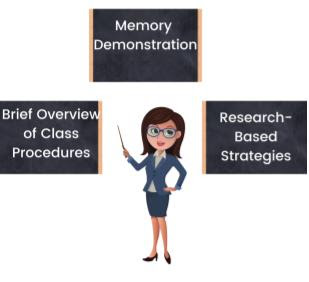School is back in session and we hope to host a relatively normal "Meet the Teacher/Open House" this year. I always look forward to meeting the parents, guardians, and other caregivers of my students. I love to see their excitement at being back in the classroom, sitting in the desks that their students normally occupy, and hearing about their student's experiences in class. But I have a confession to make; I have been teaching for 20 years and I still get nervous before every single Meet the Teacher! Over time, I have found what works best for me is to design an interactive (and fun) experience for the caregivers that mimics much of what their student actually does in class.
Presentation Overview
I organize my presentation into three different sections; a brief class overview, a short demonstration, and an explanation of the research behind the demonstration. I love to connect the demonstrations to what the students are currently doing or have done in class. In the past, I had the adults's take personality test like The Pig or The Cube. This activity leads into a discussion regarding the type of test (projective), the theoretical framework supporting it, and a discussion about test validity and reliability. These are all topics that I cover with the students during the 1st week of school. You might remember that I administer The Cube test to my students as part of their 1st Days Station Rotation! This ends up being a fun topic for discussion between the caregivers and their students as they compare results!
Memory Demonstrations
In recent years, I have shifted away from personality tests and have focused more on the principles of learning. I have found that the caregivers really appreciate information about how their students learn and the different ways that they can support their learning at home. Here are two of the demonstrations that I have used.
The Serial Position Effect: In this demonstration, I read a selection of 10 random words aloud to the participants. I then briefly distract them before asking them to write down as many words from the list that they can remember. Next, we plot out the words that they do remember on a graph and discuss the results. Many times what we see is that they remember what was the first word (primacy effect), the last word(recency effect) or any strange information (von Restorff effect). This leads into a discussion about when and how students should study. I also use this as a launchpad to talk about cognitive strategies like retrieval practice and distributed practice.
Memory Test: In this demonstration, I ask the participants to study a picture of twenty random items. I then briefly distract them and ask them to write down as many words from the picture that they can remember. With a partner, they look for patterns in terms of what they remembered and generate hypotheses as to how their memories work based on their results. This sometimes leads into discussions about the serial position effect because they tend to forget the items in the middle of the picture. It has also led to some great discussions about mnemonics and how chunking concepts together can improve memory.
There are a ton of great demonstrations out there for memory. This resource provides even more ideas that relate to deep processing, the self-reference effect, the spacing effect, the testing effect, imagery, chunking, mnemonics, and the generation effect. Whichever demonstration you choose I recommend that you do it both with the students and their caregivers so they can talk about it together.
The Science of Learning
Once we have completed the demonstration, I provide the caregivers with the "why" of the activity. Why it is important, why it works, and how to leverage this research for themselves and their students. The Learning Scientists have produced a superb website filled with research-based strategies to improve learning. They focus on six different strategies proven to lead to more effective learning:
- Retrieval Practice: Bringing previously learned information to mind.
- Spaced Practice: Spreading out studying is more effective than cramming.
- Dual Coding: Using words and visuals to represent concepts.
- Interleaving: Switching between ideas during a study session. This could include differentiating between similar concepts.
- Concrete Examples: Using specific examples for abstract concepts.
- Elaboration: Explaining and describing new ideas and connecting them to prior knowledge.
I use this time to share how these strategies are taught and reinforced during class. For example, I ask my students to use the Cornell note taking format. I share how this practice is supported by what we know about retrieval practice, spaced practice & concrete examples. I have found that both the students and their caregivers appreciate knowing the WHY behind what we do in the classroom. I even provide them with informational sheets about strategies to take home! These include the "Six Strategies for Effective Learning" poster and instructions about how to access the researcher's blog written with a specific section dedicated to parents.
I usually have about 10 minutes with each group before they move on to the next class. I have found that incorporating demonstrations makes the night more engaging and meaningful. I would love to hear what other teachers are doing for Open House! Please share what has worked for you in the past in the comment section below.
Next Post: Glimmers of Gratitude
.jpg)




Comments
Post a Comment